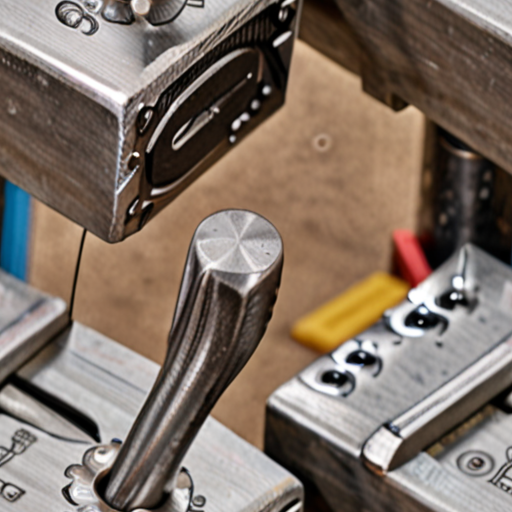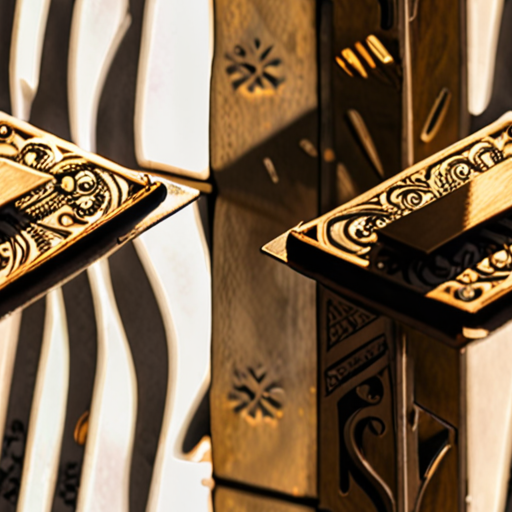For those who appreciate the art of precision and style, metal stamping has become a popular craft among enthusiasts and professionals alike. This intricate process involves shaping and molding metal into unique designs, often used in creating custom jewelry, home decor items, and other personalized accessories. With its versatility and creative possibilities, it’s no wonder why many are eager to master the techniques of stamping metal. However, with so many methods and tools available, it can be overwhelming for beginners to know where to start. In this comprehensive guide, we’ll delve into the world of metal stamping techniques, exploring the basics, advanced methods, and essential tools required to achieve professional-looking results.

Techniques of Stamping Metal
Stamping metal involves shaping and forming metal into various shapes and designs using a combination of tools and processes.
-
Piercing
Piercing is a technique used to cut out holes in metal sheets or plates. This process involves using a punch or die to create a hole in the metal, which can then be used as a starting point for further processing.
-
Coining
Coining is a technique used to shape metal into a specific design or pattern. This process involves using a die to press the metal into the desired shape, often resulting in a raised or recessed design.
-
Lancing
Lancing is a technique used to create intricate designs or patterns in metal. This process involves using a series of small punches or dies to create a detailed design, often requiring great precision and control.
-
Drawing
Drawing is a technique used to stretch or pull metal into a longer or thinner shape. This process involves using a series of rollers or dies to gradually elongate the metal, often resulting in a uniform thickness and texture.
-
Embossing
Embossing is a technique used to raise a design or pattern on the surface of metal. This process involves using a die to press the metal into the desired shape, often resulting in a raised or three-dimensional design.
-
Blanking
Blanking is a technique used to cut out a specific shape or design from a larger piece of metal. This process involves using a die to cut out the desired shape, often resulting in a precise and accurate cut.
These techniques can be used individually or in combination to create complex metal parts and components. By understanding the basics of metal stamping, manufacturers can create high-quality products with precise dimensions and intricate designs.
Benefits of Metal Stamping
Metal stamping offers several benefits, including:
- High accuracy and precision
- Fast production rates
- Low material waste
- Ability to create complex designs and shapes
By leveraging these benefits, manufacturers can create high-quality metal parts and components that meet exacting standards and specifications.
Applications of Metal Stamping
Metal stamping has a wide range of applications across various industries, including:
- Automotive
- Aerospace
- Medical devices
- Electronics
From car parts to medical implants, metal stamping plays a critical role in creating high-quality components that meet exacting standards and specifications.
Best Practices for Metal Stamping
To achieve optimal results in metal stamping, manufacturers should follow best practices, including:
- Selecting the right materials and tools
- Designing for manufacturability
- Implementing quality control measures
- Continuously monitoring and improving processes
By following these best practices, manufacturers can optimize their metal stamping processes and create high-quality products that meet exacting standards and specifications.
Four Types of Metal Stamping
Metal stamping is a versatile process used to create intricate designs and shapes on various metals. At Sweet Pea Stamps, we understand the importance of precision and accuracy in metal stamping, which is why we’re excited to share our knowledge on the four primary types of metal stamping dies: single punch dies, progressive dies, compound dies, and transfer dies.
- Single Punch Dies
- Progressive Dies
- Compound Dies
- Transfer Dies
Single punch dies are the most basic type of metal stamping die. They consist of a single punch that strikes the metal to create a specific design or shape. Single punch dies are ideal for small-scale production runs and are often used for prototyping or testing new designs.
Progressive dies are more complex than single punch dies and involve a series of punches that work together to create a specific design or shape. Progressive dies are commonly used for high-volume production runs and are ideal for manufacturing parts with multiple features.
Compound dies are similar to progressive dies but involve two or more separate dies that work together to create a specific design or shape. Compound dies are often used for manufacturing parts with complex geometries or multiple features.
Transfer dies are used to transfer a design or shape from one metal sheet to another. Transfer dies are commonly used for manufacturing parts with intricate designs or patterns.
At Sweet Pea Stamps, we offer a wide range of metal stamping services, including custom die design and manufacturing. Our team of experts has years of experience working with various metals and can help you bring your design to life. Contact us today to learn more about our metal stamping services and how we can help you achieve your goals.
Stamping Straight on Metal
To achieve crisp, clean impressions on metal surfaces, follow these steps:
- Prepare Your Surface
- Select the Right Stamp
- Apply Pressure and Technique
- Drag the Stamp Smoothly
- Check Your Progress
Metal surfaces require a smooth finish to prevent scratches and ensure even stamping.
Choose a high-quality metal stamp specifically designed for metal surfaces, taking into account the thickness and material of the metal.
Hold the stamp firmly against the metal surface, applying gentle pressure until the design catches the edge of the metal.
Once the design has caught, slowly drag the stamp along the metal surface, maintaining consistent pressure and control.
Regularly inspect your work to ensure the design is evenly stamped and free of smudges or imperfections.
For optimal results, consider investing in a metal stamping kit, which typically includes a variety of stamps, handles, and other accessories.
Sweet Pea Stamps offers a range of metal stamping tools and supplies, perfect for beginners and experienced crafters alike.
Visit our website at https://sweetpeastamps.com/ to explore our selection and learn more about metal stamping techniques.
Additionally, check out other reputable brands like Amazon and eBay for a wide range of metal stamping supplies and tools.
By following these tips and practicing your technique, you’ll be able to achieve professional-looking results and unlock your full creative potential with metal stamping.

The Basics of Metal Stamping
Metal stamping is a manufacturing process used to convert flat metal sheets into specific shapes. It is a complex process that can include a number of metal forming techniques, such as blanking, punching, bending, and piercing, to name a few.
Understanding the Process
To begin with, metal stamping involves cutting out a design or shape from a sheet of metal using a die. The die is typically made of steel or tungsten carbide and is precision-engineered to produce the desired shape. Once the metal has been cut out, it may undergo further processing, such as deburring, cleaning, and coating.
Metal Stamping Techniques
There are several metal stamping techniques used in the manufacturing process, including:
- Blanking: This involves cutting out a shape from a sheet of metal using a die.
- Punching: This involves making holes in a sheet of metal using a punch.
- Bending: This involves shaping a sheet of metal into a curved or angled shape.
- Piercing: This involves making small holes in a sheet of metal using a piercer.
Applications of Metal Stamping
Metal stamping has a wide range of applications in various industries, including:
- Automotive: Metal stamping is used to manufacture parts for vehicles, such as engine components, chassis parts, and body panels.
- Aerospace: Metal stamping is used to manufacture parts for aircraft and spacecraft, such as engine components, structural components, and fasteners.
- Medical: Metal stamping is used to manufacture medical devices, such as surgical instruments, implants, and diagnostic equipment.
- Consumer Goods: Metal stamping is used to manufacture consumer goods, such as appliances, furniture, and decorative items.
Benefits of Metal Stamping
Metal stamping offers several benefits, including:
- High accuracy: Metal stamping allows for high accuracy and precision in the production of metal parts.
- Fast production rates: Metal stamping enables fast production rates, making it ideal for large-scale manufacturing operations.
- Cost-effective: Metal stamping is a cost-effective method of producing metal parts, particularly for high-volume production runs.
- Customization: Metal stamping allows for customization of metal parts to meet specific requirements.
Conclusion
Metal stamping is a versatile manufacturing process that offers a range of benefits, including high accuracy, fast production rates, cost-effectiveness, and customization. With its wide range of applications in various industries, metal stamping is an essential process in modern manufacturing.
Choosing the Right Metal Stamping Technique for Your Project
When selecting a metal stamping technique for your project, there are several key considerations to keep in mind. These factors can impact the overall outcome of your project, affecting precision, efficiency, and ultimately, its success. At Sweet Pea Stamps, we understand the importance of mastering metal stamping techniques, which is why we’ve outlined the essential considerations below:
- Material Selection: Different materials require distinct approaches to metal stamping. For instance, softer metals like aluminum may require less force and pressure compared to harder metals like steel.
- Tooling Complexity: The intricacy of your design will determine the level of tooling required. Simple designs might necessitate basic tools, whereas intricate patterns demand more advanced equipment.
- Production Volume: The scale of your project influences the choice of metal stamping technique. High-volume productions often benefit from automated processes, whereas smaller batches may be better suited for manual methods.
- Metal Thickness: Thicker metals pose challenges due to increased rigidity, requiring specialized tools and techniques to achieve precise results.
- Design Complexity: Intricate designs with many details or curves may necessitate custom-made dies or specialized stamping tools.
- Surface Finish: Desired surface finishes, such as polished or textured, can dictate the choice of metal stamping technique and subsequent processing steps.
- Cost and Budget: Metal stamping costs vary depending on the chosen method, material, and tooling requirements. Establishing a budget beforehand helps guide your decision-making process.
- Time Constraints: Meeting deadlines requires efficient metal stamping techniques. Automated processes can expedite production, but may compromise on precision.
To further enhance your understanding of metal stamping techniques, consider exploring resources from reputable manufacturers like HobbyLincor MetalCraft. These companies offer valuable insights into the world of metal stamping, covering topics such as tooling, materials, and best practices.At Sweet Pea Stamps, we’re committed to helping you master metal stamping techniques. Our extensive collection of stamps and dies caters to various skill levels and project requirements. Visit our website to discover the perfect tools for your next project: https://sweetpeastamps.com/.By carefully evaluating these key considerations and staying informed about the latest metal stamping techniques, you’ll be well-equipped to tackle even the most complex projects with confidence. Happy crafting!
Mastering Different Metal Stamping Techniques
To unlock expert skills in metal stamping, it’s essential to master various techniques, from basic designs to intricate patterns.
-
Understanding Metal Stamping Basics
Metal stamping involves using specialized tools to shape and mold metal into desired forms. To get started, you’ll need to understand the basics of metal stamping, including the types of metals commonly used, the necessary tools and equipment, and safety precautions.
-
Selecting the Right Metals
The type of metal you choose will depend on the project’s requirements and your personal preference. Common metals used in metal stamping include copper, aluminum, and steel.
-
Choosing the Right Tools
You’ll need a variety of tools to complete metal stamping projects, including hammers, punches, dies, and anvils. Invest in high-quality tools to ensure accuracy and precision.
-
Safety Precautions
Metal stamping can be hazardous if proper safety precautions aren’t taken. Wear protective gear, including gloves, safety glasses, and a face mask, to prevent injury.
-
-
Developing Basic Design Skills
Basic design skills are essential for creating simple yet effective metal stamped pieces. Practice drawing and sketching designs to develop your skills.
-
Learning Basic Shapes and Forms
Familiarize yourself with basic shapes and forms, including circles, squares, triangles, and rectangles. These shapes will serve as the foundation for more complex designs.
-
Experimenting with Textures and Patterns
Add texture and pattern to your designs by experimenting with different techniques, such as embossing, etching, and stamping.
-
-
Advanced Techniques for Intricate Designs
Once you’ve mastered basic design skills, it’s time to move on to advanced techniques for intricate designs. Practice working with complex shapes, patterns, and textures.
-
Working with Complex Shapes
Practice working with complex shapes, including curves, spirals, and geometric patterns.
-
Creating Intricate Patterns
Develop your skills in creating intricate patterns, including mandalas, florals, and abstract designs.
-
Conclusion
Mastery of metal stamping techniques requires patience, practice, and dedication. By understanding the basics, developing basic design skills, and advancing to intricate designs, you’ll become a skilled metal stamper capable of creating beautiful and unique pieces.

0 Comments